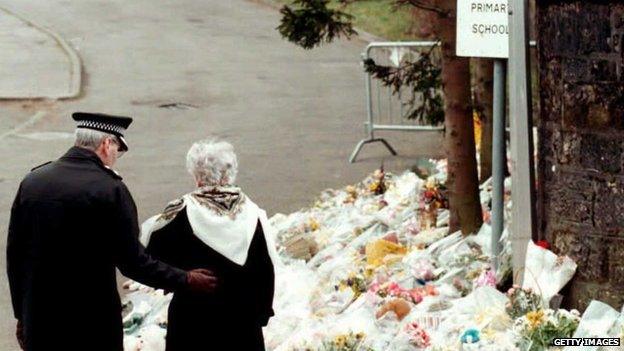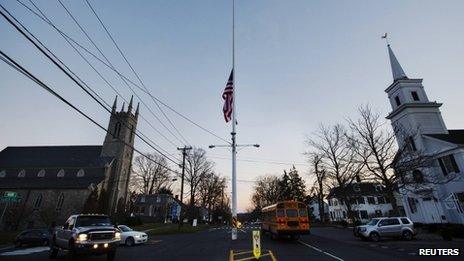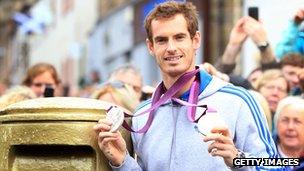Connecticut shootings: The lessons from Dunblane
- Published

In the aftermath of the school shootings in 1996, Dunblane grieved together as a community
The shootings at a school in Newtown, Connecticut have shocked the world. The BBC's Scotland correspondent Colin Blane describes how the town of Dunblane recovered from a similar tragedy.
When I heard about the shootings at the elementary school in Connecticut, I thought immediately of Dunblane.
It is more than 16 years since that attack but there are some events which are so awful, so arbitrary they are marked by an indelible notoriety.
What happened on 13 March 1996 was the worst school shooting ever perpetrated in Britain. Sixteen children were killed - most of them just five years old. Their teacher was also shot.
The impact of the crime was shocking.
One Dunblane resident recalled how anxious parents waited outside the primary school to learn whether their children had lived or died.
She told me: "It was like a coal mine disaster with the families united in their suffering."
Dunblane is a small town, close enough to the city for commuting, far enough to be considered a good place to bring up kids.
In the days after the massacre, Dunblane grieved as a community. The churches worked together to offer what comfort they could.
The next Sunday service in Dunblane Cathedral was broadcast live across the UK. There was a sense that Dunblane was confronting the evil which been visited on the town.
There was, of course, interest in the shootings from around the world just as there is now in what has happened in Newtown.

In Newtown, Connecticut, a flag flies at half mast
When emotions are raw, such attention is often unwelcome.
After three days, community leaders asked the camera crews to pull back and there was, for a time, a pooling of resources. Some editors felt they should try to limit what was bound to be seen as insensitive intrusion.
Inevitably, though, the Dunblane families have suffered from continued attention down the years. There have been so many reasons to revisit the story.
Soon after the shootings, a public inquiry was set up a few miles away in Stirling. For weeks, every detail of the massacre and the events which led up to it were investigated.
Local people came to listen to the evidence, to try to gain some understanding of a crime which still seemed inexplicable.
Out of the massacre came a determination that something should be done to prevent a similar horror in future.
There was the Snowdrop Campaign, calling for a ban on the private ownership and use of handguns in Britain.
The campaign was named after the small spring flowers which had already begun to come out on that cold March morning. Some 700,000 people signed the Snowdrop petition and the law was changed.
There was legislation too, raising standards of school security across the UK.
No longer would it be easy for an unauthorised adult to wander into a primary school gymnasium with four handguns and 700 rounds of ammunition, as Thomas Hamilton had done in Dunblane.
In Scotland, the link between the availability of guns and the number of people shot dead every year is accepted. Since Dunblane, the public have remained firmly in favour of keeping firearms out of private hands.
This year, five people have been killed by guns in Scotland. That's in line with the rest of the UK per head of population and a death rate 50 times lower than in the United States.
Over the years, Dunblane has changed. The town has expanded. All the children who survived the shooting that day have grown up and left school.
Many of the families whose children died have remained in the area. They didn't feel leaving Dunblane was necessary to get them away from what had happened.

Thanks to Andy Murray, Dunblane now has happier associations for outsiders
And in the last few years, there's been a new reason for outsiders to know of Dunblane.
One of the older children at Dunblane Primary School in March 1996 was the tennis champion, Andy Murray, who remembers being told to take cover in another classroom.
For the last eight years, most of my visits to the town have been because of him. Dunblane was given a gold post box after his Olympic triumph and the pubs and hotels have enjoyed sharing his Grand Slam finals with TV crews and newspaper writers.
But the town will always have its reminders of the school shootings.
There's a memorial standing stone in the Cathedral and money raised after the tragedy went to build a sports and community centre where commemorative snowdrops are etched into the windows.
Where once the massacre was almost unspeakable, now there is a quiet recognition of what the Dunblane families suffered.
You can follow the Magazine on Twitter, external and on Facebook, external